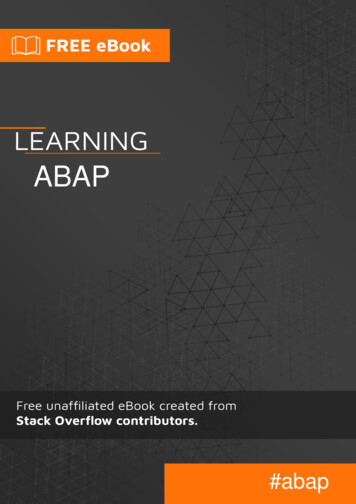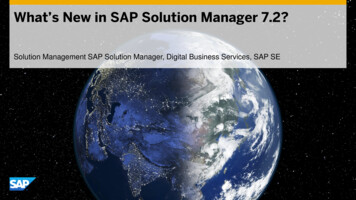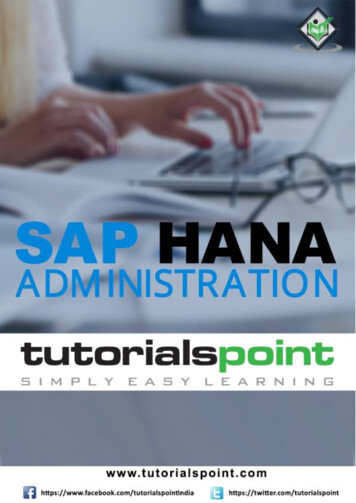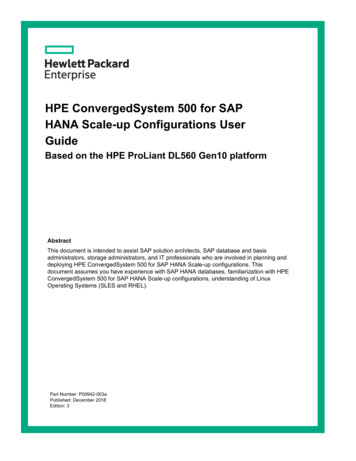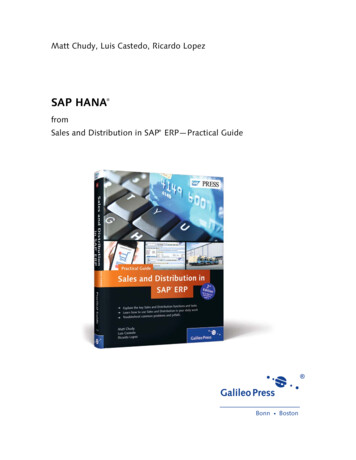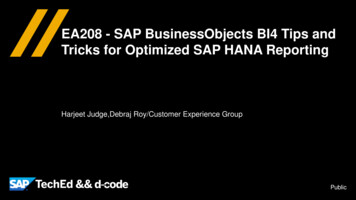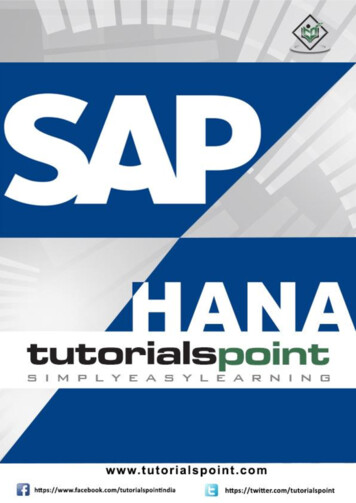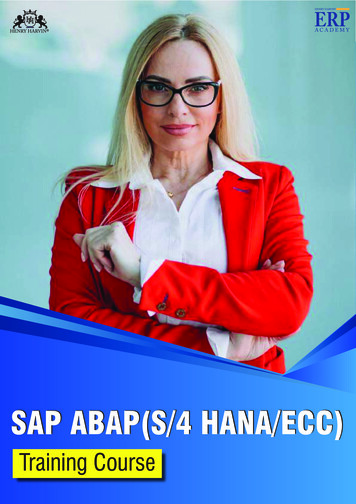
Transcription
SAP ABAP(S/4 HANA/ECC)Training Course
ContentsAbout the Course03Key Features04Course Curriculum05Henry Harvin ’s Training Methodology07Learning Benefits08Career Benefits09Our Clientele10Media Recognition11Reviews & Rankings12About Henry Harvin Education13
About the Course9 in 1 CourseTRAINING44 Hours of Live OnlineInteractive Classroom SessionsPROJECTSFacility to undergo variousHands-on Projects for Practicallearning of the CourseINTERNSHIPInternship Assistance togain practical experience ofthe learningsPLACEMENT100% Placement Assistancefor 1-Year, post successfulcompletionE-LEARNING ACCESSWith abundant toolsand techniques, videocontent, assessments,and moreCERTIFICATIONDistinguish your profile with theCourse Completion Certificationof SAP ABAP Training Courseand showcase expertiseBOOTCAMPSRegular Bootcampsspread over the next 12monthsWRITING HACKATHONSFree Access to #AskHenryHackathons andCompetitionsMEMBERSHIPGet 1-Year Gold Membership ofHenry Harvin ERP Academyfor the SAP ABAP TrainingCourse
Key FeaturesGuaranteed InternshipPost TrainingCertification for the completionof SAP ABAP Training Course12 Bootcamps as part of the#AskHenry SeriesMobile App Access to MoodleE-Learning Portal010203040506070809Attend Unlimited Batches withDifferent Instructors for the next 1year without paying anything extra100% PlacementAssistance for 1 Year1-Year Gold Membership of HenryHarvin ERP Academy24x7 Lifetime Support & AccessAccess to 5 Soft Skills Courses toenhance Employability
Course CurriculumSAP ABAP (S/4 HANA)Module 1: Introduction to HANA Introduction to eclipse HANA Studio HANA ModelingModule 2: Architecture of ABAP for HANA Evolution and architecture Overview for ABAP meets HANA Code to data paradigm Performance Impact Table creation using Wizard in databaseModule 3: External View Hana Based views in ABAP Source Code External views define mapping Create & use external views in Hana Use ABAP report to consume Display Content using ALVModule 4: CDS View CDS view: Overview Create simple CDS viewModule 5: Nested CDS View Nested CDS View: Overview Functions & Case Statements Association, Filters & ParametersModule 6: ABAP Development Change for HANA Authorization Annotation, CDS Odata Annotations VDM view CDS hierarchy ALV-IDSModule 7: AMDP Introduction Database Procedures & AMDP Debugging AMDP AMDP BADI CDS Table FunctionsModule 7: Advanced Topics Transport Management Error Analysis
Course CurriculumSAP ABAP (ECC)Module 1: Introduction to SAP ABAPIn this module, the candidate will learn about Advanced Business Application Programming of SystemApplication and Product, which includes understanding SAP Architecture, Features, ABAP Development Tools,ERP and SAP, and R/3 Architecture SAP Overview SAP Architecture SAP Features ABAP Development tools Enterprise Resource Planning (ERP) SAP and R/3 Architecture ABAP/4 overviewModule 2: ABAP Dictionary and Data TypesIn this module, the candidate will learn about ABAP Dictionary, Tables, Domains, Structure, Indexes, Buffering,Views, Type tools, Primary and Foreign Keys, Numeric Characters, String Etc What is ABAP Dictionary? Tables, domains, and data elements Structure, table types, and objects Indexes and buffering Views, lock objects, search helps, and type pools Primary Key and Foreign Key Table maintenance generator Numeric character, integer, floating-point Time, strings, date, packed decimalsModule 3: ABAP ProgrammingIn this module the candidate will learn about ABAP Programming which includes, Using Loops and Branches,Code Inspector, Opening and Updating SQL Statements, Internal Tables, I/O statements and Formattingcommands, and Runtime analysis Using Loops and Branches If, else if, factorial and small programs, code inspector Message classes and selection screens Open and update SQL Statement Insert and select Delete, update and modify Internal tables and field symbols I/O statement and formatting commands Runtime analysis and performance trace
Course CurriculumModule 4: Debugging and Modularization TechniqueIn this module, the candidate will learn about Debugging and Modularization Technique, which includes anunderstanding of System Variables, Table, mode, Watchpoints, Utilization of debugging editor, ModularizationTechnique, Subroutines, Function Modules, and Groups and Passing parameters Introduction on debugging your program System variables Table mode Watchpoints and breakpoints Utilizing debugging editor What is a modularization technique? Subroutines Includes Function modules and function groups Passing parameters and tables to subroutinesModule 5: Report ProgrammingIn this module, the candidate will learn about Classical Report Events, Interactive Reports, Control LevelCommands, Hotspot, and Selection Screens Classical report events Interactive reports Control level commands Hotspot, Hide, Get cursor techniques Selection screensModule 6: Application Link EnablingIn this module, the candidate will learn about Application Link Enabling Features, Inbound and Outboundprocesses, Configuration, Distribution Scenarios, Local System, Developing Ports, and Customer DistributionModel ALE introduction and its features Inbound and outbound processes ALE configuration ALE distribution scenarios Logical system RFC destination Developing ports Customer distribution model
Course CurriculumModule 7: Intermediate Document (IDOC)In this module, the candidate will learn about Intermediate Document, which includes understanding, itsstructure, Message Type, Developing IDOC Type, IDOC Enhancements, and Segment elements Introduction and features of IDOC Structure, message type, and IDOC type Developing IDOC types, message types, and process codes IDOC enhancements Segment definition and elementsModule 8: RFC and WorkFlowIn this module the candidate will learn about Remote Function Call, which includes Interaction Mechanism usingRFC, ABAP Artefacts, Developing Program using Remote enabled functions, Workflow, Creation of Standardtasks and templates About RFC and Interaction mechanism using RFC TRFC Vs ARFC ABAP interfaces Developing program using remote enabled functions RFC destination between two systems Overview of workflow Creation of standard tasks and templates Development of workflow builder and prefixModule 8: Module 9: Business Application Programming Interface (BAPI) and Business Add-Ins (BADI)In this module, the candidate will learn about the Business Application Programming Interface and SapBusiness objects, Features, and working of BAPI. The student will also learn about BADI and its implementation Definition of BAPI and SAP business objects Features of BAPI & Developing BAPI Working with BAPI Introduction to BADI Implementation of BADI
Henry Harvin ’s Training MethodologyLive ProjectsLive Projects are carried out during the training tenure to develop experiential learning for theparticipants. This helps in better understanding of the concepts and gain in-depth practicalinsight.Unique PedagogyUses a mix of techniques aligned to our unique G.C.A.O. pedagogy. This enables participantsto derive focused-action-oriented outcomes from the trainingParticipants will be engaged throughout the training through reverse presentations, groupEnd-to-End Engagement activities, brainstorming sessions, and hands-on experience over both statistical and nonstatistical tools. Idea is to focus on value creationCertification Process1CounsellingConsult one of thecounselors and get intothe Right Batch.Register yourself for theSAP ABAP TrainingCourse234Attend the Training inSAP ABAP CourseSubmission ofProjects AssignedComplete the SAP ABAPTraining CourseAttend the Instructor-LedSessions of the SAP ABAPTraining Course and getyour Course CompletionCertification. Go Throughthe Recorded Sessions, incase you missed any topicor trainingSubmit the Hand-onProjects assigned duringthe training to the Trainersfor Assessment andCertificationPost Completion of thetraining, get CourseCompletion Certification ofSAP ABAP Training Coursefrom Henry Harvin ERPAcademy in front of yourname. Post it on Social Mediaand apply for internship andFreelancing ProjectsNEINA (SAP ABAP)
Learning BenefitsCreate Business OrientedApplications to boost the growth0102Write Programs by implementingABAP Programming Basics, String/data Operations, Syntax Check,Covering Formatting0304Be well versed with features likeALE, BADI, ALV, IDOC, RFC, LSMW,and moreLearn to Create Programs usingLoops, Branches, Module Pools, filehandling, and Scripting0506Acquire Understandingabout Test and Analysis Tools, suchas The Syntax Check and the DebuggerApprehend different types of data,terminology & Dictionary Conceptsof ABAP including Structures, tables,buffers, indexes, and moreGain Knowledge about FactorialProgram, Field Strings, Field Symbols,and Different Internal Tables0708Work with Workbench Organizer whichperpetuates multiple development projectsand manages their distribution
Career BenefitsExposure to Millions of Jobs Globally inthe Arena of SAP ABAP01Get Hired by International Brandslike Google, Amazon, JP Morgan, andother top brands in the industry02Be Highly Paid as a Freelancer or as afull-time Professional after the Successfulcompletion of SAP ABAP Training Course03Improve your CV & LinkedIn Profilewith Technical & Professionaldevelopment04Distinguish your Profile from peers andget Promoted in Current Profile with mostin-demand Skills05Distinguish your profile with theCourse Completion Certificationof SAP ABAP Training Courseand showcase expertise0607Better Job Security with exceptionalgrowth opportunities“Spreading knowledge in a range of disciplines and fields, delivering quality higher education at all levels, servingnational needs, and furthering international public interest.” Financial Express
Our ClienteleCORPORATE CLIENTELECOLLEGE CLIENTELE180 Corporates110 Colleges
Media Recognition37 Media Recognitions
5 5Reviews& Rankings5 1.,1* % 3257 /6 5 5 1600 Google Reviews300 Youtube Video Testimonials
About Henry Harvin EducationAs a competency and career development organization, Henry Harvin Education develops,enhances, and promotes select skill-sets that are deemed essential to changing times. Embedding‘Value Creation’ at the core of its vision, Henry Harvin Education partners with best in industryorganizations and empanels domain experts to transform careers of the diverse audience fromindustry and academia by harnessing the power of skill centric training programs. These programsare carefully handcrafted to deliver tangible output for its learners by creating a distinguishedbiosphere of the latest learning technologies, effective content, and experienced trainers. HenryHarvin Education is inspired by the contributions of Mr.Henry Dunster (First President of America’sOldest University) to the education industry which has sustained for over 400 years.About Henry Harvin ERP AcademyHenry Harvin ERP Academy has been set up with an objective to advance the professionaljourney by upskilling them with key skills. These skills are imparted through action-orientedlearning solutions that are carefully handcrafted by subject matter experts with extensive industryexperience. These learning solutions are delivered using our unique goal-centric pedagogy byselect professionals from leading organizations who also impaneled as domain experts with theacademy. This enables the academy in achieving its goal of empowering professionals to reachtheir full professional potential. Henry Harvin ERP Academy aims to function in its outreachgeographies and upskill 100,000 professionals till 2030!henryharvin.com 91 9015266266hello@henryharvin.com 91 9891953953
SAP ABAP (S/4 HANA) Module 1: Introduction to HANA Introduction to eclipse HANA Studio HANA Modeling Module 2: Architecture of ABAP for HANA Evolution and architecture Overview for ABAP meets HANA Code to data paradigm Performance Impact Table creation using Wizard in database Module 3: External View

